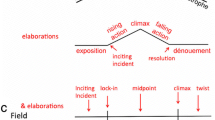Abstract
In demonstration, speakers use real-world activity both for its practical effects and to help make their points. The demonstrations of origami mathematics, for example, reconfigure pieces of paper by folding, while simultaneously allowing their author to signal geometric inferences. Demonstration challenges us to explain how practical actions can get such precise significance and how this meaning compares with that of other representations. In this paper, we propose an explanation inspired by David Lewis’s characterizations of coordination and scorekeeping in conversation. In particular, we argue that words, gestures, diagrams and demonstrations can function together as integrated ensembles that contribute to conversation, because interlocutors use them in parallel ways to coordinate updates to the conversational record.
Similar content being viewed by others
Notes
We reserve the term demonstration for practical actions, though Clark (1996) uses the term more broadly to cover a wide range of communicative actions, including also iconic gestures and mimicry of quoted speech.
Lewis developed his theory of the conversational record in a totally separate project from his work on coordination and convention. The two strands of research address rather different problems in the philosophy of language, and, perhaps surprisingly, Lewis himself never explored the connection between the two proposals. We believe, however, that there is a natural affinity between them. For example, combining the ideas makes it possible to characterize the domain of semantics in terms of conventions for updating the conversational record (Stojnic and Lepore 2014) and to show how such conventions provide standards for interpreting utterances in context (Lepore and Stone 2014). The development in this paper represents another combined application of Lewis’s ideas.
John Blackburne has published a simple animation presenting the insight of this proof at http://en.wikipedia.org/wiki/File:Pythag_anim.gif.
Not all coherence theorists would agree with us here; Lepore and Stone (2014) explores the dialectic in more detail.
References
Alperin, R.C. 2000. A mathematical theory of origami constructions and numbers. New York Journal of Mathematics, 6: 119–133.
Alperin, R.C., and R.J. Lang 2009. One, two and multi-fold origami axioms. In Origami, eds. R.J. Lang and A K Peters, 4, 371–394.
Asher, N., and A. Lascarides. 2003. Logics of conversation. Cambridge: Cambridge University Press.
Barker, C. 2002. The dynamics of vagueness. Linguistics and Philosophy, 25(1): 1–36.
Bavelas, J.B., and N. Chovil. 2000. Visible acts of meaning: An integrated message model of language in face-to-face dialogue. Journal of Language and Social Psychology, 19(2): 163–194.
Clark, H.H. 1983. Making sense of nonce sense. In The process of language understanding, eds. G.F. d’Arcais, and R. Jarvella, 297–331. London: John Wiley and Sons.
Clark, H.H. 1996. Using language. Cambridge.
Clark, H.H., and M.A. Krych. 2004. Speaking while monitoring addressees for understanding. Journal of Memory and Language, 50: 62–81.
Dennett, D.C. 1978. Brainstorms. Bradford Books.
Engle, R.A. 2000. Toward a theory of multimodal communication: Combining speech, gestures, diagrams and demonstrations in instructional explanations Thèse de doctorat non publiée. Stanford University.
Fodor, J.A. 1983. The Modularity of Mind: An Essay on Faculty Psychology. MIT.
Greenberg, G. 2013. Beyond resemblance. The Philosophical Review, 122(2): 215–287.
Grice, H.P. 1957. Meaning. The Philosophical Review, 66(3): 377–388.
Hobbs, J. 1990. Literature and cognition. CSLI.
Hobbs, J.R. 1979. Coherence and coreference. Cognitive Science, 3(1): 67–90.
Huzita, H. 1989. Understanding geometry through origami axioms. In Proceedings of the first international meeting of origami science and technology, ed. H. Huzita, 215–222.
Justin, J. 1989. Resolution par le pliage de l’équation du troisième degré et applications géometriques. In Proceedings of the first international meeting of origami science and technology, ed. H. Huzita, 251–261.
Kehler, A. 2001. Coherence, reference and the theory of grammar. CSLI.
Kendon, A. 2004. Gesture: Visible action as utterance. Cambridge.
Lang, R.J. 2010. Origami and geometric constructions. Online Tutorial. http://www. langorigami.com.
Lascarides, A., and M. Stone. 2009a. Discourse coherence and gesture interpretation. Gesture, 9(2): 147–180.
Lascarides, A., and M. Stone. 2009b. A formal semantic analysis of gesture. Journal of Semantics, 26(3): 393–449.
Lepore, E., and M. Stone 2014. Imagination and convention: Distinguishing grammar from inference in language. Oxford.
Lewis, D.K. 1969. Convention: A philosophical study. Harvard.
Lewis, D.K. 1979. Scorekeeping in a language game. Journal of Philosophical Logic, 8: 339–359.
Maor, E. 2007. The pythagorean theorem: A 4,000 year history. Princeton University Press.
McNeill, D. 1992. Hand and mind: What gestures reveal about thought. Chicago.
Montague, R. 1970. Universal grammar. Theoria 36(3): 373–398.
Roberts, C. 2012. Information structure: Towards an integrated formal theory of pragmatics. Semantics and Pragmatics, 5(6): 1–69.
Shin, S.J. 1995. The logical status of diagrams. Cambridge: Cambridge University Press.
Sperber, D., and D. Wilson 1986. Relevance: Communication and congition. Harvard.
Stojnic, U., and E. Lepore 2014. What’s what’s said? In What is said and what is not: The semantics–pragmatics interface, eds. C. Penco, and F. Domaneschi, 17–36. CSLI Publications.
Stojnic, U., M. Stone, and E. Lepore. 2013. Deixis (even without pointing). Philosophical Perspectives, 26(1): 502–525.
Thomason, R.H. 1990. Accommodation, meaning and implicature. In Intentions in communication, eds. R. Cohen, J. Morgan, and M.E. Pollack, 325–363. Cambridge: MIT Press.
Acknowledgments
This research was supported in part by NSF IIS-1017811. Preliminary versions have been presented at colloquia and UCLA, CUNY, Edinburgh and Rutgers, and in talks at the Amsterdam Colloquium–Semdial joint session and the Rutgers–Jagiellonian Conference on Cognitive Science. This presentation benefits from comments from audiences there, from Sam Cumming, Doug DeCarlo, Eileen Kowler and Rochel Gelman, and the referees of this issue, and particularly from extensive discussion with Gabe Greenberg and Ernie Lepore.
Author information
Authors and Affiliations
Corresponding author
Rights and permissions
About this article
Cite this article
Stone, M., Stojnic, U. Meaning and Demonstration. Rev.Phil.Psych. 6, 69–97 (2015). https://doi.org/10.1007/s13164-014-0213-4
Received:
Accepted:
Published:
Issue Date:
DOI: https://doi.org/10.1007/s13164-014-0213-4




